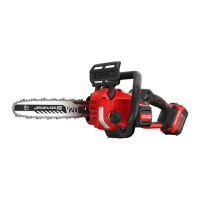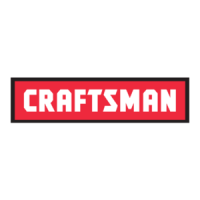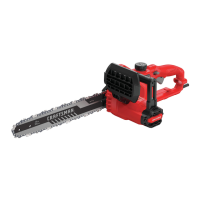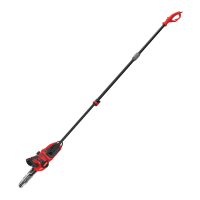5
ENGLISH
Chainsaw Names and Terms
• Bucking - The process of cross cutting a felled tree or log
intolengths.
• Motor Brake - A device used to stop the saw chain when
the trigger isreleased.
• Chain Saw Powerhead - A chain saw without the saw
chain and guidebar.
• Drive Sprocket or Sprocket - The toothed part that
drives the sawchain.
• Felling -
The process of cutting down atree.
• Felling Back Cut -
The final cut in a tree felling operation
made on the opposite side of the tree from the notchingcut.
• Front Handle - The support handle located at or toward
the front of the chainsaw.
• Front Hand Guard - A structural barrier between the
front handle of a chain saw and the guide bar, typically
located close to the hand position on the fronthandle.
• Guide Bar - A solid railed structure that supports and
guides the sawchain.
• Scabbard/Guide Bar Cover - Enclosure fitted over guide
bar to help prevent tooth contact when saw is not inuse.
• Kickback - The backward or upward motion, or both
of the guide bar occurring when the saw chain near the
nose of the top area of the guide bar contacts any object
such as a log or branch, or when the wood closes in and
pinches the saw chain in thecut.
• Do not attempt operations beyond your capacity or
experience. Read thoroughly and understand completely
all instructions in this manual.
• Before you start chain saw, make sure saw chain is
not contacting any object.
• Do not operate a chain saw with one hand! Serious
injury to the operator, helpers, or bystanders may
result from one handed operation. A chain saw is
intended for two-handed use only.
• Keep the handles dry, clean, and free of oil orgrease.
• Do not allow dirt, debris, or sawdust to build up on
the motor or outside air vents.
• Stop the chain saw before setting it down.
• Do not cut vines and/or small under brush.
• Use extreme caution when cutting small size brush
and saplings because slender material may catch
the saw chain and be whipped toward you or pull
you off balance.
• Keep the working area free from obstructions such
as other trees, branches, rocks, fences, stumps, etc.
Eliminate or avoid any obstruction that your saw chain could
hit while you are cutting through a particular log orbranch.
• Cut one log at atime.
• Use extreme caution when re-entering a previous
cut. Engage ribbed bumpers into wood and allow saw
chain to reach full speed before proceeding withcut.
• Do not attempt plunge cuts or borecuts.
• Watch for shifting logs or other forces that could
close a cut and pinch or fall intosaw chain.
• Kickback, Pinch -
The rapid pushback of the saw
which can occur when the wood closes in and pinches
the moving saw chain in the cut along the top of the
guidebar.
• Kickback, Rotational - The rapid upward and backward
motion of the saw which can occur when the moving saw
chain near the upper portion of the tip of the guide bar
contacts an object, such as a log orbranch.
• Limbing - Removing the branches from a fallen tree.
• Low-Kickback Chain - A chain that complies with the
kickback performance requirements of ANSI B175.1–2012
(when tested on a representative sample of chain saws.)
• Normal Cutting Position - Those positions assumed in
performing the bucking and fellingcuts.
• Notching Undercut - A notch cut in a tree that directs
the tree’sfall.
• Rear Handle - The support handle located at or toward
the rear of thesaw.
• Reduced Kickback Guide Bar - A guide bar which has
been demonstrated to reduce kickbacksignificantly.
• Replacement Saw Chain - A chain that complies with
kickback performance requirements of ANSI B175.1–2012
when tested with specific chain saws. It may not meet
the ANSI performance requirements when used with
othersaws.
• Saw Chain - A loop of chain having cutting teeth, that
cut the wood, and that is driven by the motor and is
supported by the guidebar.
• Ribbed Bumper - The ribs used when felling or bucking
to pivot the saw and maintain position whilesawing.
• Switch - A device that when operated will complete or
interrupt an electrical power circuit to the motor of the
chainsaw.
• Switch Linkage - The mechanism that transmits motion
from a trigger to theswitch.
• Switch Lockout - A movable stop that prevents
the unintentional operation of the switch until
manuallyactuated.
Additional Safety Information
WARNING: ALWAYS use safety glasses. Everyday
eyeglasses are NOT safety glasses. Also use face or
dust mask if cutting operation is dusty. ALWAYS WEAR
CERTIFIED SAFETYEQUIPMENT:
• ANSI Z87.1 eye protection (CAN/CSA Z94.3),
• ANSI S12.6 (S3.19) hearing protection,
• NIOSH/OSHA/MSHA respiratoryprotection.
WARNING: Some dust created by power sanding,
sawing, grinding, drilling, and other construction
activities contains chemicals known to the State
of California to cause cancer, birth defects or
other reproductive harm. Some examples of these
chemicalsare:
• lead from lead-based paints,
• crystalline silica from bricks and cement and other
masonry products, and
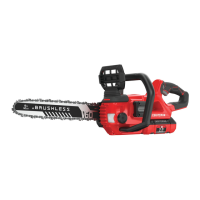
